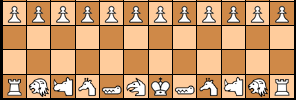Comments/Ratings for a Single Item
Grasshoppers capture by displacement, but airplanes don't--they capture the enemy piece, if any, on the next-to-last square of the airplane's move. Also, an airplane can jump over any number of men of either or both colors, making it much more mobile than a queen, but a grasshopper can only jump a single piece and so can be blocked.
The idea of buying an army with points definitely allows for a good handicap system, and it's also possible to equalize White's and Black's chances by giving Black a little more to spend.
I love the idea of buying pieces for each game, and wish someone would implement this on a server. (Wouldn't that be a terrific attraction to add to the growing gamesmagazine-online website, for instance!) That's the only idea for a CV I've ever heard that would actually merit being forecast as 'the future of Chess.' The piece values and the players' budgets for hiring their armies would have to depend on the size and shape of the board, right? And probably on the relative strength of the players -- one thing that strikes me as especially appealing about this concept being its usefulness for handicapping.
Airplane Chess was never marketed commercially (nor was any other CV I've invented). The opening pawn setup is based on Turkish Grand Chess; the knights were the clear choice to start on the second-rank.
It's been many years since I played it, but I checked my notes, and my estimated value for an airplane was 6.2 points (compared with 5.1 for a rook, 3.4 for a bishop, 3.2 for a knight, 1.0 for a pawn). However, this was apparently for an 8x8 board; values may change slightly on a 10x10 board.
Footnote: Long ago I tried to work out values for many unorthodox chess pieces for use in a generalized chess game in which players would be given points to spend to buy their armies, and the players need not buy the same pieces at all. Taking it one step further, pieces not purchased for a certain number of games would have their costs reduced by 0.1 points (perhaps in some central computer?), while pieces that are purchased frequently would have their costs go up--a supply and demand system to empirically determine relative piece values as closely as possible in time. Around the same time Ralph Betza had a related idea (Betza's Simple Army Chess) to test relative piece values by pitting armies of different piece types against each other and seeing which one wins.
9 comments displayed
Permalink to the exact comments currently displayed.
